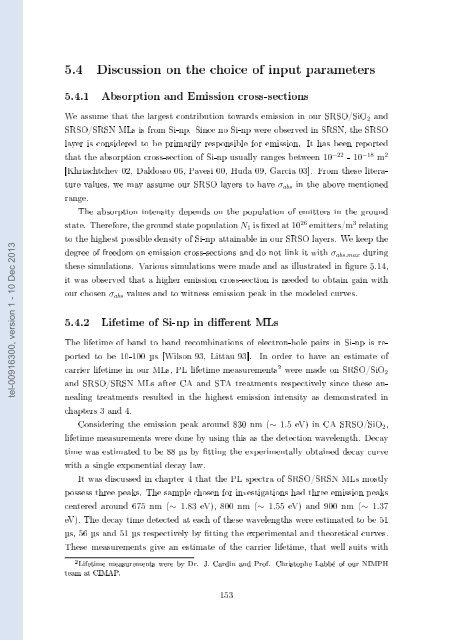Films minces à base de Si nanostructuré pour des cellules ...
Films minces à base de Si nanostructuré pour des cellules ...
Films minces à base de Si nanostructuré pour des cellules ...
You also want an ePaper? Increase the reach of your titles
YUMPU automatically turns print PDFs into web optimized ePapers that Google loves.
5.4 Discussion on the choice of input parameters<br />
5.4.1 Absorption and Emission cross-sections<br />
tel-00916300, version 1 - 10 Dec 2013<br />
We assume that the largest contribution towards emission in our SRSO/<strong>Si</strong>O 2 and<br />
SRSO/SRSN MLs is from <strong>Si</strong>-np. <strong>Si</strong>nce no <strong>Si</strong>-np were observed in SRSN, the SRSO<br />
layer is consi<strong>de</strong>red to be primarily responsible for emission. It has been reported<br />
that the absorption cross-section of <strong>Si</strong>-np usually ranges between 10 −22 - 10 −18 m 2<br />
[Khriachtchev 02, Daldosso 06, Pavesi 00, Huda 09, Garcia 03]. From these literature<br />
values, we may assume our SRSO layers to have σ abs in the above mentioned<br />
range.<br />
The absorption intensity <strong>de</strong>pends on the population of emitters in the ground<br />
state. Therefore, the ground state population N 1 is xed at 10 26 emitters/m 3 relating<br />
to the highest possible <strong>de</strong>nsity of <strong>Si</strong>-np attainable in our SRSO layers. We keep the<br />
<strong>de</strong>gree of freedom on emission cross-sections and do not link it with σ abs.max during<br />
these simulations. Various simulations were ma<strong>de</strong> and as illustrated in gure 5.14,<br />
it was observed that a higher emission cross-section is nee<strong>de</strong>d to obtain gain with<br />
our chosen σ abs values and to witness emission peak in the mo<strong>de</strong>led curves.<br />
5.4.2 Lifetime of <strong>Si</strong>-np in dierent MLs<br />
The lifetime of band to band recombinations of electron-hole pairs in <strong>Si</strong>-np is reported<br />
to be 10-100 µs [Wilson 93, Littau 93]. In or<strong>de</strong>r to have an estimate of<br />
carrier lifetime in our MLs, PL lifetime measurements 2 were ma<strong>de</strong> on SRSO/<strong>Si</strong>O 2<br />
and SRSO/SRSN MLs after CA and STA treatments respectively since these annealing<br />
treatments resulted in the highest emission intensity as <strong>de</strong>monstrated in<br />
chapters 3 and 4.<br />
Consi<strong>de</strong>ring the emission peak around 830 nm (∼ 1.5 eV) in CA SRSO/<strong>Si</strong>O 2 ,<br />
lifetime measurements were done by using this as the <strong>de</strong>tection wavelength. Decay<br />
time was estimated to be 88 µs by tting the experimentally obtained <strong>de</strong>cay curve<br />
with a single exponential <strong>de</strong>cay law.<br />
It was discussed in chapter 4 that the PL spectra of SRSO/SRSN MLs mostly<br />
possess three peaks. The sample chosen for investigations had three emission peaks<br />
centered around 675 nm (∼ 1.83 eV), 800 nm (∼ 1.55 eV) and 900 nm (∼ 1.37<br />
eV). The <strong>de</strong>cay time <strong>de</strong>tected at each of these wavelengths were estimated to be 51<br />
µs, 56 µs and 51 µs respectively by tting the experimental and theoretical curves.<br />
These measurements give an estimate of the carrier lifetime, that well suits with<br />
2 Lifetime measurements were by Dr. J. Cardin and Prof. Christophe Labbé of our NIMPH<br />
team at CIMAP.<br />
153
















